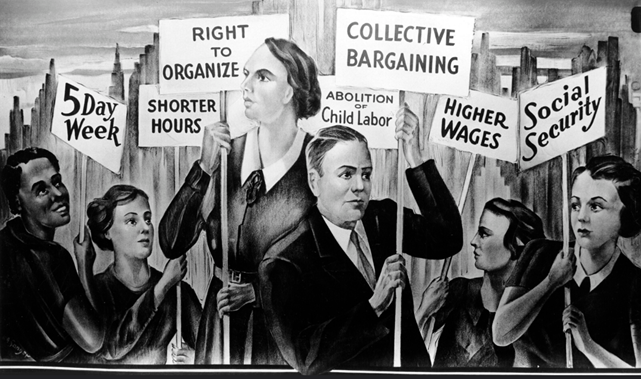Organized
Labor

What happens if workers are paid too little?
What if they have to work in unsafe conditions? There are groups that speak for
workers in order to protect their interests. In this section, you will learn
about organized labor.
Key Terms
ü collective bargaining: when union leaders meet with employers
to talk about workers' pay, working hours, and benefits
ü labor union: an organization that works for its members'
interests, such as fair wages, working conditions, benefits, and hours
ü strike: when workers refuse to go to work in order to get company
leaders to listen to their demands
Let’s Practice!
About
Organized Labor
You have learned that wages are determined by
supply and demand. However, sometimes workers feel that they are not being paid
fairly. They might be asked to work too many hours or to work in unsafe
conditions. A worker who feels that he or she is being treated unfairly has the
option of quitting the job. The worker could find a new job with an employer
who offers better wages and working conditions.
However, some American workers try to get control
of their working conditions. They do this by joining together to take their
concerns to company management. A group of workers that does this is called a labor union. A labor union is an
organization that works for its members' interests, such as fair wages, working
conditions, benefits, and hours.
In the late 1800s, many people who lived in
American cities worked in factories. Most factories were dangerous. Factory
owners did not want to pay extra money to make the factories safe for workers.
The machines in factories had no safety devices, and workers could easily get
their clothing, hands, arms, or legs stuck in the fast-moving machines. Many
workers were injured, and thousands died each year in factory accidents.
Factory employees also had to work long hours
for little pay. Because there were so many people looking for jobs, employees
were easy to replace. Therefore, the wages were low. It was not unusual for a
workday to last more than 12 hours. Some workers did not even get the weekends
off. They might have gotten one day off every two weeks. Factory owners set
these long hours because they knew the workers needed their jobs to survive.
Workers felt trapped in dangerous, low-paying
jobs. They wanted someone to speak for them. Many members of the labor force
decided to get together in organized groups. They formed unions that would
protect their interests. Founded in the late 1800s, the Knights of Labor and
the American Federation of Labor were two of the first labor unions to be
established.
Unions used the strike to get employers to listen to their demands. During a
strike, workers refused to go to work until the company manager agreed to talk
about their demands. The workers would protest in front of the factories
instead of going to work. Sometimes, the strikes became violent. Unions tried
to get higher pay, an eight-hour workday, and safer workplaces for union
members.
Employers did not like unions. Some refused to
hire people who belonged to unions. Employers made workers sign contracts
saying that they would not join a union. Congress passed laws that helped
unions. In 1935, the Wagner Act gave workers the right to join unions and to
bargain with their employers.
Unions began using collective bargaining before they went on strike. During collective
bargaining, union leaders met with employers to talk about things like pay,
working hours, and benefits for workers. The employees only went on strike if
collective bargaining did not succeed.
Labor unions in the United States today include
the:
• American Federation of Labor- Congress of Industrial Organizations
• American Postal Workers Union
• American Federation of Teachers
Let’s Practice!